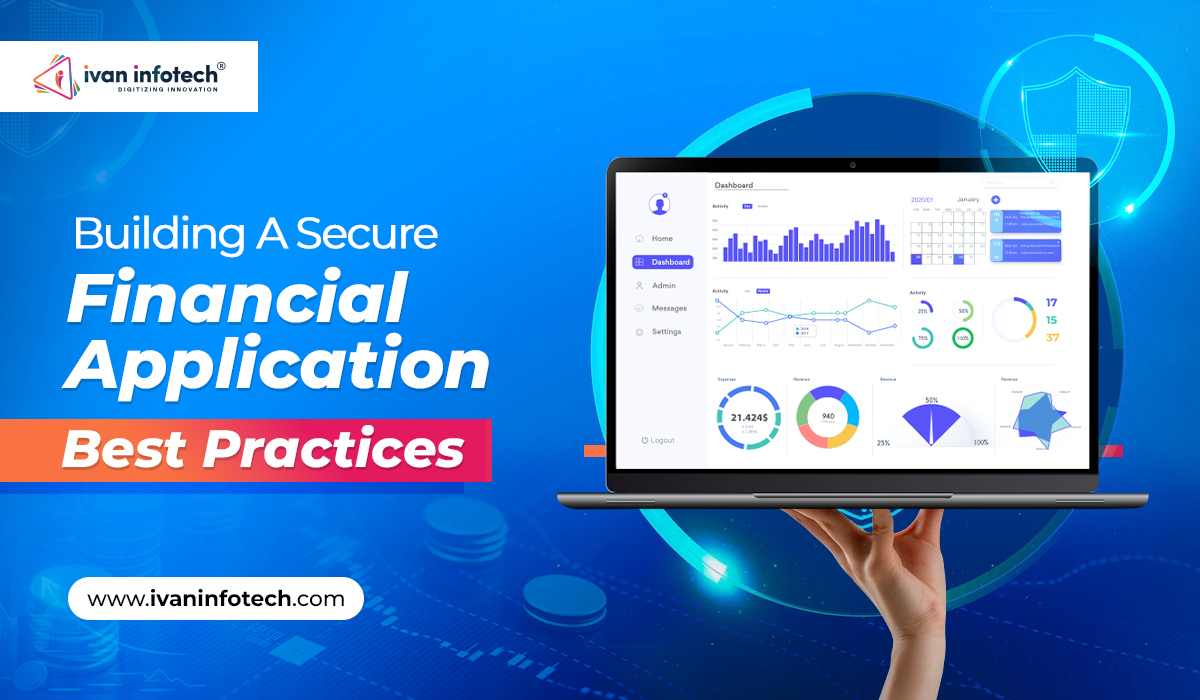
A Secure Financial Application Development Process
With the advancement of technology, digitization is overhauling the financial world, where mobile and web applications are now becoming an important medium through which customer manages their finances. But with this comes even more responsibility – to ensure sensitive financial data is safe and secure. In an era when cyber security threats are continually increasing, financial institutes need to take the upper hand in building secure applications that protect user data and offer trust. In this blog, we will explore the best practices for secured financial application development. So keep reading –
Understand Regulatory Compliance
Why It Matters ?
A developer must familiarise themselves with all the rules and regulations even before he or she begins with financial software development. It is crucial to comply with the latest government rules to ensure the safety of users’ data and avoid huge penalties.
Steps to know:-
- Understand Relevant Regulations: The kind of regulations differ from one business to another.
- Build in Compliance from Day One: You incorporate compliance requirements into the development lifecycle. This ensures that your application is compliant with any pertinent legal regimes from day one.
Carry out a Comprehensive Risk Assessment
Why It Matters ?
A good risk assessment is a comprehensive analysis of all the vulnerabilities within your application and the infrastructure surrounding it during financial application development.
Actions
- Perform threat modeling: Develop an understanding of your application’s architecture and potential attack vectors.
- Third-Party Auditors: It would be wise to hire security specialists from outside the organization for a more objective identification of potential weak points.
Robust Authentication Controls
Why It Matters ?
A good authentication method is one of the powerful controls over user accounts.
Activities To Be Accomplished
- Implement Multi-Factor Authentication: Authentication should be done through different authentications like passwords, SMS codes, and biometric data.
- Adaptive Authentication: Authentication is based on behavior and context like from a certain location or from a particular device.
Encrypted Data Transmissions
Why It Matters ?
Transmitted data is susceptible to interception. Therefore, the connection between the client and server must be secured.
Steps to be Taken
- Use HTTPS: Use HTTPS for all network data transmissions so that such data is always encrypted. This bars man-in-the-middle attacks.
- Implement TLS: Implement Transport Layer Security (TLS) to further secure the data transmission.
Secure Sensitive Data
Why Data Encryption is Necessary ?
Though data in transit must be protected, data at rest must also be safeguarded so that it is not accessed without authorization.
What to Do
- Use Strong Encryption Algorithms: Use standard industry algorithms for encrypting your sensitive information while availing financial software development services.
- Protect Your Encryption Keys: Have tight access controls on encryption keys, and also consider using HSMs for key management.
Patch and Upgrade Software
Why It Is Important ?
Cyber security threats are constantly evolving; hence, the a need for constant updates in software.
How to Proceed ?
- Implement a Patch Management System: Conduct regular vulnerability checks on third-party libraries and frameworks during financial application development.
- Schedule Regular Updates: Plan schedules for regular review of your application’s security posture.
Adopt Secure Coding Practices
Why It Is Important
The foundation of a secure application is how it has been coded.
How to Proceed
- Follow Guidelines: Be in accordance with the prescribed guidelines for secure coding.
- Code Reviews Periodically review the code to identify security issues and best practices.
Monitoring and Activity Logging
Why You Should Monitor
Monitoring your application for suspicious activity will allow you to respond and react in near real-time to a threat.
Steps
- Implement Logging: Log every user action and system event.
- Use Anomaly Detection Tools: Leverage machine learning-based tools that track abnormal patterns of behaviour.
Recurring Security Testing
Why It Is Important ?
Recurring security testing helps you discover weaknesses in your application.
Steps to Take ?
- Penetration Tests: Engage ethical hackers to carry out mock attacks against your application
- Automated Tools: Leverage automated security scanning tools, which could detect vulnerabilities in real-time during financial software development.
Educate Users on Security Best Practices
Why It Is Important ?
Even the strongest application can be compromised by user negligence.
Action To Take ?
- Provide Security Awareness Training: Let them learn materials on how to recognize phishing and the importance of password strength.
- Remind Them to Change Passwords Often: Tell the users to change their passwords sometimes and not to duplicate it with other applications.
Incident Response Plan
Why It Is Important
Even while taking all possible precautions, there is a possibility of a breach, and therefore, it must be pre-planned to limit the damage.
Actions To Undertake
- Incident Response Plan: Determine the procedures and practices to be followed during the data breach and other roles and responsibilities.
- Periodic Drills Exercise: Conduct simulated drills to test your incident response plan so you are prepared for such an incident.
Teamwork in Security
Why It Is Important
Your team needs to be part of the security during financial application development.
Actions to Take
- As Best Practice, Implement Security throughout Development Lifecycle: Put security into every aspect of development from planning through deployment.
- Promote Staff Training: Train your staff constantly so that they are able to learn as much as possible about what is going on in the world of security.
Employee Training
Why It Is Important
Employees are frequently the first line of defense against a security threat when it comes to internal customers.
Actions to Take
- Conduct Routine Security Training: Regular training sessions updating the latest security threats and best practices among employees.
- Promote a Reporting Culture: Create an environment where employees can feel free to report their suspicion of a security concern or suspected breach.
Behavioral Analytics
Why It Is Important
Behavioural analytics can help identify anomalies that may be indicative of fraud during financial application development.
Steps to Take:
- Implement User Behavior Monitoring: Monitor for the app users’ activities to look for anomalous behaviour that may indicate an attack.
- Utilize Machine Learning: Use algorithms for enhanced anomaly detection.
Adopt a Security-First Development Lifecycle
Why It Is Important
Integrating security with each phase of the development lifecycle will dramatically improve the security posture of your application.
Action to take
- Adopt DevSecOps Practices: Apply security practices in your DevOps processes so that continuous security evaluation is provided.
- Automate Security Checks: Security tests can be automated through CI/CD pipelines with this method, and vulnerabilities can be caught early.
Conclusion
Financial application development is a compounded task requiring delicate planning, continuous vigilance, and good practices. A robust application developed with an understanding of regulatory compliance, meticulous risk assessment, sound authentication mechanisms, and a security-first culture is well-positioned to protect user data and maintain a high level of trust.
Subscribe to the Newsletter
Don’t lag behind in the ever-evolving age. Stay updated with all tech news and trends. We will not fill your inbox with spam mails. You will only receive updates about the cream contents.
Want Assistance with Software Development?
Anything you need in terms of software, you can count on us. With knowledge, skills and years of experience, we create tailor-made, integrated development solutions with high-end technologies.























Categories
Ai software solution
API Development Services
app development
Application Maintenance
AR And VR Software Development
AR Software Development
Artificial Intelligence
Asset Tracking
Automated system
Big Data
Block Chain Development
Blockchain Development Solution
Blog
cloud computing solutions
CMS Development Services
Construction Software Solution
CRM
custom web application
Digital Asset Management
Digital Marketing
Digital Services
Ecommerce Industry Solutions
ecommerce solution provider
Education Software Development
education software development Solution
Education Software Solution
ERP Software Development
Event Ticketing Software Solution
Finance Software Solution
Food and beverage software
Graphic Design
Healthcare software solution
hospitality software development solutions
hotel software solution
IMS
IOT
IT application development
IT Consultancy
IT services
IT solutions
Java
Java App Development
Lead Generation Services
Legal Software Development
mobile app design
opensource software development
pos software development Solution
Quality Assurance
Real estate software
Restaurant Software Solution
Retail IT Solutions
Retail Management Software
software development
Software Security
Software Testing
Sports Software Development
Supply Chain Software Solution
Transportation Software Development
Travel & Hospitality
UI and UX design
Uncategorized
Web Design
Web development service
Web Programming